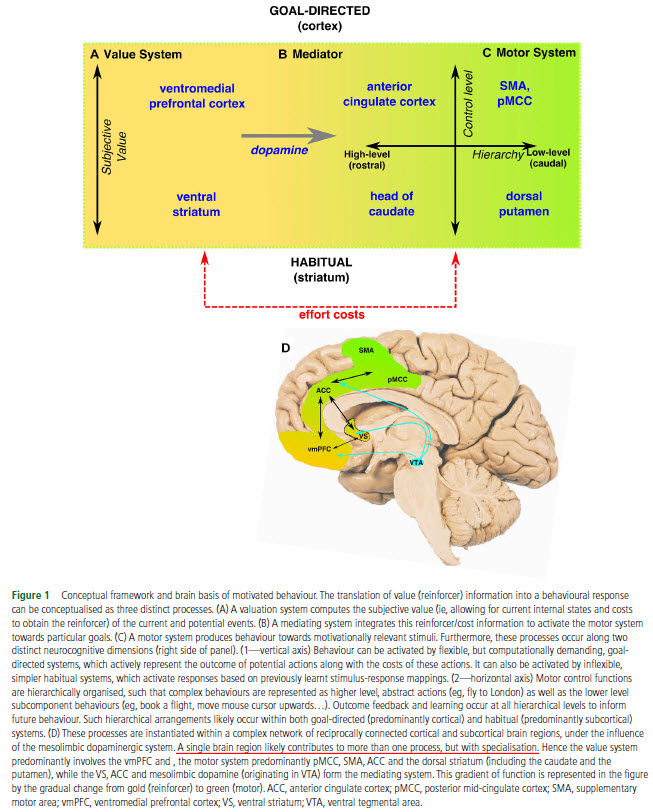Le Heron et al. (2018) defines apathy as a marked reduction in goal-directed behavior. But in order to move, one must be motivated to do so. Therefore, a generalized form of impaired motivation also hallmarks apathy.
The authors compiled for us a nice mini-review combing through the literature of motivation in order to identify, if possible, the neurobiological mechanism(s) of apathy. First, they go very succinctly though the neuroscience of motivated behavior. Very succinctly, because there are literally hundreds of thousands of worthwhile pages out there on this subject. Although there are several other models proposed out-there, the authors’ new model on motivation includes the usual suspects (dopamine, striatum, prefrontal cortex, anterior cingulate cortex) and you can see it in the Fig. 1.

After this intro, the authors go on to showcasing findings from the effort-based decision-making field, which suggest that the dopamine-producing neurons from ventral tegmental area (VTA) are fundamental in choosing an action that requires high-effort for high-reward versus a low-effort for low-reward. Contrary to what Wikipedia tells you, a reduction, not an increase, in mesolimbic dopamine is associated with apathy, i.e. preferring a low-effort for low-reward activity.
Next, the authors focus on why are the apathetic… apathetic? Basically, they asked the question: “For the apathetic, is the reward too little or is the effort too high?” By looking at some cleverly designed experiments destined to parse out sensitivity to reward versus sensitivity to effort costs, the authors conclude that the apathetics are indeed sensitive to the reward, meaning they don’t find the rewards good enough for them to move. Therefore, the answer is the reward is too little.
In a nutshell, apathetic people think “It’s not worth it, so I’m not willing to put in the effort to get it”. But if somehow they are made to judge the reward as good enough, to think “it’s worth it”, they are willing to work their darndest to get it, like everybody else.
The application of this is that in order to get people off the couch and do stuff you have to present them a reward that they consider worth moving for, in other words to motivate them. To which any practicing psychologist or counselor would say: “Duh! We’ve been saying that for ages. Glad that neuroscience finally caught up”. Because it’s easy to say people need to get motivated, but much much harder to figure out how.
This was a difficult write for me and even I recognize the quality of this blogpost as crappy. That’s because, more or less, this paper is within my narrow specialization field. There are points where I disagree with the authors (some definitions of terms), there are points where things are way more nuanced than presented (dopamine findings in reward), and finally there are personal preferences (the interpretation of data from Parkinson’s disease studies). Plus, Salamone (the second-to-last author) is a big name in dopamine research, meaning I’m familiar with his past 20 years or so worth of publications, so I can infer certain salient implications (one dopamine hypothesis is about saliency, get it?).
It’s an interesting paper, but it’s definitely written for the specialist. Hurray (or boo, whatever would be your preference) for another model of dopamine function(s).
REFERENCE: Le Heron C, Holroyd CB, Salamone J, & Husain M (26 Oct 2018, Epub ahead of print). Brain mechanisms underlying apathy. Journal of Neurology, Neurosurgery & Psychiatry. pii: jnnp-2018-318265. doi: 10.1136/jnnp-2018-318265. PMID: 30366958 ARTICLE | FREE FULLTEXT PDF
By Neuronicus, 24 November 2018

